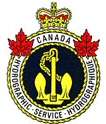Canadian Hydrographic Service
| Service hydrographique du Canada | |
|
Canadian Hydrographic Service crest | |
| Agency overview | |
|---|---|
| Formed | 1883 |
| Headquarters | Ottawa, Ontario |
| Minister responsible | |
| Agency executive |
|
| Parent agency | Fisheries and Oceans Canada Science Sector |
| Website | http://www.charts.gc.ca |

Retired Canadian Hydrographic Service logo or crest
The Canadian Hydrographic Service (CHS) is Canada's hydrographic office, responsible to gather, manage, transform and dessiminate bathymetric, hydrographic and nautical information into paper and electronic nautical charts and publications including Notices to Shipping and/or Notices to Mariners for safe and efficient navigation in Canadian waters including performing hydrographic surveys. CHS also represents Canada in the International Hydrographic Organization.
History
Prior to Confederation, responsibilities for hydrographic survey and chart production in British North America rested with the Royal Navy.[1]
In 1882, the loss of the steamship SS Asia on an uncharted shoal in Georgian Bay resulted in 150 fatalities and was Canada's worst maritime disaster at the time. On August 13, 1883, the Dominion government established the Georgian Bay Survey which was empowered by legislation with the responsibility to survey and chart navigable waters of Georgian Bay and Lake Huron.
Surveying and charting was extended to Canada's Pacific coast in 1891, tidal and current metering nationwide began in 1893, surveying and charting extended to the Maritimes by 1905, and water level gauging of the Great Lakes began in 1912.[1]
In 1904, a Privy Council order renamed the Georgian Bay Survey to the Hydrographic Survey of Canada with some modified responsibilities. In 1913 one of Canada's most famous hydrographic survey vessels, CSS Acadia was commissioned for use on the Atlantic coast. In 1928, the organization was renamed to the current name Canadian Hydrographic Service. Responsibility was extended on March 31, 1949 with the entry of Newfoundland into Confederation, with CHS taking over surveys and charting around the island of Newfoundland and the coast of Labrador from the Royal Navy.[1]
Technology
CHS has been a world leader in the adoption of hydrographic survey technology, as well as in research and development. With responsibility for charting the world's longest coastline (243,792 kilometres) as well as 6.55 million square kilometres of continental shelf and territorial waters (2nd largest in the world) including extensive inland waterways such as the St. Lawrence Seaway, CHS uses relatively meagre financial resources to maintain a world-record inventory of over 1000 published charts, and as such, the organization was an early adopter of single-beam sonar, radio-navigation positioning systems, and computer processing and storage.
The joint Canada-U.S. DEW Line also necessitated innovative surveying techniques throughout remote northern areas in the Canadian Arctic Archipelago in support of ships carrying logistics and construction material. CHS is one of the only hydrographic offices in the world with the capability to undertake Arctic surveying, frequently operating in waters which are frozen between 10–12 months of the year.
CHS has migrated from single-beam sonar to becoming a major user of multibeam echo sounder sonar systems coupled with GPS to achieve improved survey accuracies. CHS was also one of the first organizations in the world to develop airborne LiDAR technology, with the LARSEN-500 sensor being used for remote Arctic surveys. Survey data processing software provided by companies such as CARIS and Helical Systems, as well as the development of Oracle Spatial database storage, are spin-offs from research developments at CHS, and are now used throughout the world by other Hydrographic Offices and in the geo-spatial technology industry. CHS demonstrates international leadership in Crowd-Source Bathymetry, Satellite-Derived Bathymetry and Marine Spatial Data Infrastructurce.
Department of Fisheries and Oceans
Unlike most nations, the CHS is not part of Canada's navy, but is rather a civilian scientific organization under the federal government's Department of Fisheries and Oceans (DFO).[1] Science Sector. Most of the survey vessels employed by CHS are nominally crewed and operated by the Canadian Coast Guard, also part of DFO. The CHS also works in collaboration with Royal Canadian Navy and other ships and vessels of opportunity from other International Hydrographic Offices primarily the US Office of Coastal Survey (OCS) of the National Ocean Service (NOS) of the National Oceanic and Atmospheric Administration (NOAA) and other Academic and Industry partners.
The incumbent of the Director General of CHS position is also called the "Hydrographer General of Canada", to reflect the important liability associated with the responsibilities coming from the previous original title "Dominion Hydrographer" tradition which dates to the earliest days of hydrographic surveying in Canada.
CHS offices
- CHS Dartmouth Office, Bedford Institute of Oceanography (BIO), Dartmouth, Nova Scotia
- CHS Sidney Office, Institute of Ocean Sciences (IOS), Sidney, British Columbia
- CHS St. John's Office, Northwest Atlantic Fisheries Centre (NAFC), St. John's, Newfoundland and Labrador
- CHS Mont-Joli Office, Maurice Lamontagne Institute (MLI), Mont-Joli, Quebec
- CHS Burlington Office, Canada Centre for Inland Waters (CCIW), Burlington, Ontario
- CHS Ottawa Office, Ottawa, Ontario
Notes and references
External links
- Canadian Hydrographic Service - Official web site
- Hydrography
- About the Canadian Hydrographic Service
- History of the CHS
- Sydney Oskar Wigen
